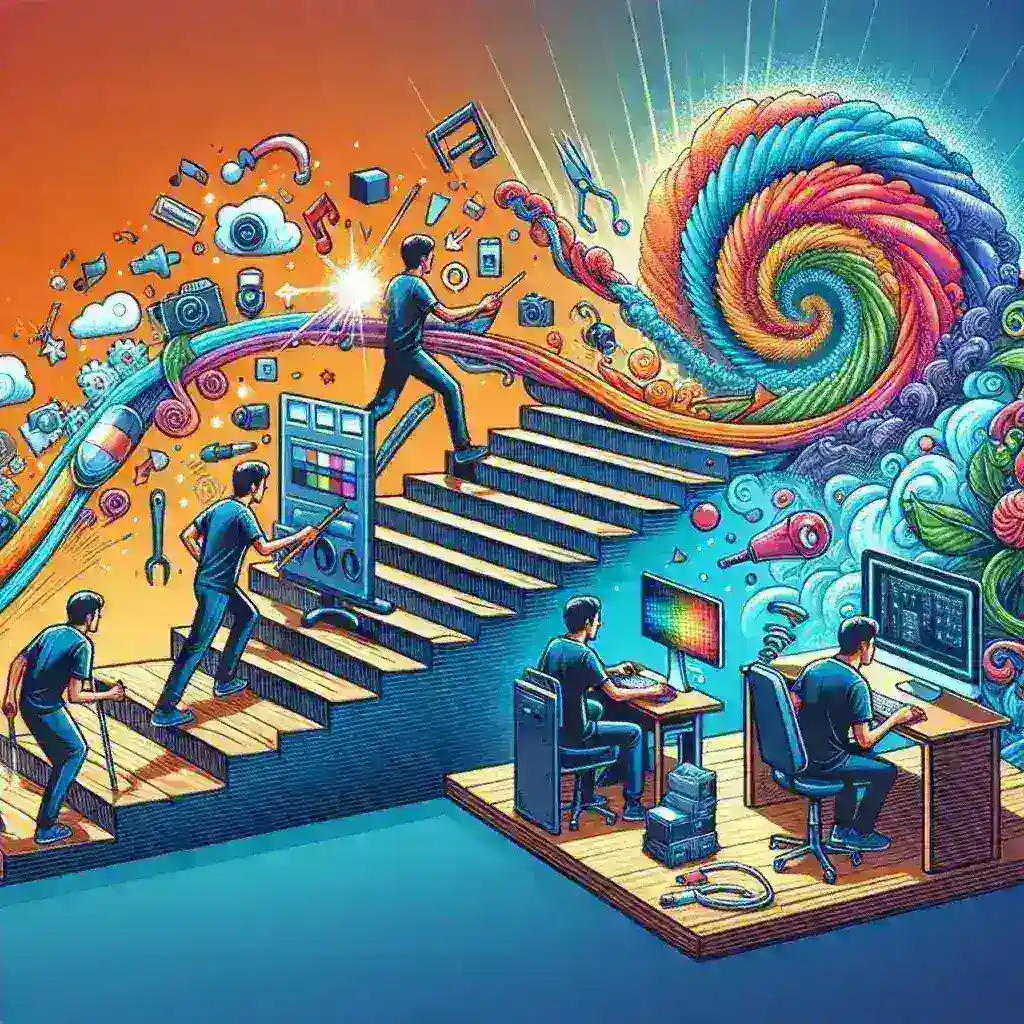The Rise of Animated Intros in Digital Content
In today’s fast-paced digital landscape, capturing your audience’s attention within the first few seconds has become more crucial than ever. Animated intros serve as the gateway to your content, setting the tone and creating anticipation for what’s to come. Whether you’re a YouTuber, educator, business owner, or content creator, having a professional-looking animated introduction can significantly impact your brand’s perception and audience engagement.
The good news? You don’t need years of design training or expensive software to create compelling animated intros. With the evolution of user-friendly tools and platforms, anyone can produce high-quality animations that rival those created by professional designers.
Understanding the Fundamentals of Animated Intros
Before diving into the creation process, it’s essential to understand what makes an effective animated intro. Successful animated introductions typically share several key characteristics that contribute to their effectiveness and memorability.
Key Elements of Effective Animated Intros
- Duration: Keep it between 5-15 seconds to maintain viewer attention
- Brand consistency: Incorporate your logo, colors, and typography
- Clear messaging: Communicate your brand or content theme effectively
- Visual appeal: Use engaging animations and transitions
- Audio integration: Include appropriate music or sound effects
Understanding these fundamentals will guide your creative decisions and ensure your animated intro serves its intended purpose of engaging and informing your audience.
Top No-Design-Skills-Required Tools for Creating Animated Intros
The market is flooded with intuitive platforms designed specifically for non-designers. These tools offer pre-made templates, drag-and-drop functionality, and automated features that simplify the animation process considerably.
Template-Based Platforms
Canva stands out as one of the most accessible options for beginners. Its extensive library of animated intro templates covers various industries and styles. Users can simply select a template, customize text and colors, and export their creation within minutes.
Renderforest offers a more specialized approach to animated intros, providing hundreds of customizable templates ranging from corporate presentations to gaming channels. The platform’s intuitive interface allows users to preview changes in real-time.
Animaker provides a comprehensive suite of animation tools with a focus on simplicity. Its character-based animations and pre-designed scenes make it particularly suitable for educational content and storytelling.
AI-Powered Solutions
Artificial intelligence has revolutionized the animation creation process. Lumen5 and similar AI-driven platforms can automatically generate animated intros based on your brand colors, industry, and preferences. These tools analyze successful animation patterns and apply them to your specific requirements.
Step-by-Step Guide to Creating Your First Animated Intro
Creating your first animated intro doesn’t have to be overwhelming. Following a systematic approach will help you achieve professional results while building confidence in your creative abilities.
Phase 1: Planning and Conceptualization
Start by defining your brand identity and the message you want to convey. Consider your target audience, the platforms where you’ll use the intro, and the overall tone of your content. Sketch out basic ideas or create a mood board to visualize your concept.
Gather your brand assets, including logos, color codes, fonts, and any existing visual elements. Having these materials organized will streamline the creation process and ensure consistency across your animated intro.
Phase 2: Template Selection and Customization
Browse through available templates on your chosen platform and select one that aligns with your brand aesthetic. Look for templates that offer the right balance of visual elements and customization options.
Begin customizing the template by replacing placeholder text with your brand name or tagline. Adjust colors to match your brand palette and upload your logo or other brand elements. Most platforms allow you to modify timing, transitions, and effects to better suit your preferences.
Phase 3: Animation and Timing Refinement
Pay careful attention to the pacing of your animation. Ensure that text appears long enough to be read comfortably but doesn’t linger unnecessarily. Smooth transitions between elements create a more professional appearance.
Experiment with different animation styles available in your chosen tool. Some platforms offer options like fade-ins, slide transitions, zoom effects, and rotation animations. Choose effects that complement your brand personality rather than overwhelming the viewer.
Phase 4: Audio Integration
Sound design plays a crucial role in creating memorable animated intros. Many platforms provide royalty-free music libraries and sound effects that you can incorporate into your animation.
Select audio that matches the mood and energy of your content. For corporate presentations, consider subtle, professional soundtracks. For gaming or entertainment content, more dynamic and energetic music might be appropriate.
Advanced Techniques for Elevating Your Animated Intros
Once you’ve mastered the basics, several advanced techniques can help your animated intros stand out from the competition without requiring extensive design knowledge.
Motion Graphics and Kinetic Typography
Kinetic typography involves animating text to create visual interest and emphasize key messages. Many user-friendly platforms now offer preset text animations that can transform static words into dynamic visual elements.
Experiment with different text entrance and exit effects. Consider how the movement of words can reinforce your message or create emotional impact. For example, words that “build” or “construct” themselves might be perfect for architecture or engineering content.
Color Psychology and Visual Hierarchy
Understanding basic color psychology can significantly improve the effectiveness of your animated intros. Warm colors like red and orange create energy and excitement, while cool colors like blue and green convey trust and professionalism.
Establish a clear visual hierarchy by using size, color, and animation timing to guide the viewer’s attention. Your most important elements (like your brand name) should be the most prominent and memorable parts of the animation.
Optimizing Animated Intros for Different Platforms
Different platforms have varying requirements and best practices for animated content. Understanding these nuances will help you create intros that perform well across multiple channels.
Social Media Considerations
For Instagram and TikTok, vertical formats work best, and shorter durations (3-5 seconds) are more effective due to users’ scrolling habits. These platforms favor bold, eye-catching visuals that translate well on mobile devices.
YouTube intros can be slightly longer (8-12 seconds) and should focus on establishing channel branding early in the video. Consider creating variations of your intro for different video types or series within your channel.
Professional and Educational Contexts
For business presentations or educational content, animated intros should prioritize clarity and professionalism over flashy effects. Subtle animations and clean typography often work better in these contexts.
Consider creating multiple versions of your intro for different professional contexts. A version for client presentations might be more conservative than one used for internal team meetings or social media content.
Common Mistakes to Avoid When Creating Animated Intros
Learning from common pitfalls can save you time and help you create more effective animated intros from the start.
Technical and Design Pitfalls
One of the most frequent mistakes is creating intros that are too long or complex. Remember that attention spans are short, and your intro should enhance rather than delay access to your main content.
Avoid using too many different fonts, colors, or animation styles within a single intro. Consistency and simplicity often produce more professional and memorable results than overly complex designs.
Brand and Messaging Issues
Ensure your animated intro accurately represents your brand personality and values. An intro that doesn’t align with your content or brand voice can create confusion and disconnect with your audience.
Don’t forget to consider your intro’s scalability across different devices and screen sizes. What looks great on a desktop computer might not translate well to mobile viewing.
Measuring Success and Iterating Your Animated Intro
Creating an animated intro is not a one-time task. Successful content creators regularly evaluate and refine their intros based on performance data and audience feedback.
Key Performance Indicators
Monitor metrics such as viewer retention during the intro segment, overall engagement rates, and audience feedback. If viewers consistently skip or drop off during your intro, it may be too long or not engaging enough.
A/B testing different versions of your animated intro can provide valuable insights into what resonates best with your audience. Try variations in length, style, or messaging to optimize performance.
Staying Current with Trends
Animation trends evolve constantly, influenced by new technologies, cultural shifts, and platform algorithm changes. Stay informed about current design trends while maintaining your unique brand identity.
Consider refreshing your animated intro periodically to keep your content feeling fresh and current. This doesn’t mean completely redesigning every few months, but subtle updates can help maintain audience interest.
Future Trends in Accessible Animation Creation
The landscape of animation creation continues to evolve rapidly, with new technologies making professional-quality animations increasingly accessible to non-designers.
Artificial intelligence and machine learning are driving the development of more sophisticated automated animation tools. These technologies can analyze successful animations and automatically generate options tailored to specific industries or brand personalities.
Virtual and augmented reality technologies are beginning to influence traditional animation creation, offering new possibilities for immersive intro experiences. While still emerging, these technologies may soon become as accessible as current 2D animation tools.
Voice-activated design tools and natural language processing are making it possible to create animations through simple voice commands or text descriptions, further reducing the barrier to entry for non-designers.
Conclusion: Empowering Creative Expression Without Design Barriers
The democratization of animation creation tools has opened unprecedented opportunities for content creators, educators, and business professionals to enhance their digital presence with professional-quality animated intros. By leveraging user-friendly platforms, following best practices, and understanding your audience’s needs, you can create compelling animated introductions that effectively represent your brand and engage your viewers.
Remember that the most successful animated intros combine technical proficiency with authentic brand expression. Focus on clarity, consistency, and audience value rather than trying to incorporate every available feature or effect. With practice and experimentation, you’ll develop the confidence and skills needed to create animated intros that truly enhance your content and strengthen your brand presence across digital platforms.
The journey from complete beginner to confident animation creator is more accessible than ever before. Start with simple templates and basic customizations, then gradually explore more advanced features as your comfort level and creative vision expand. Your unique perspective and brand voice, combined with these accessible tools, will result in animated intros that authentically represent your content and connect with your intended audience.




